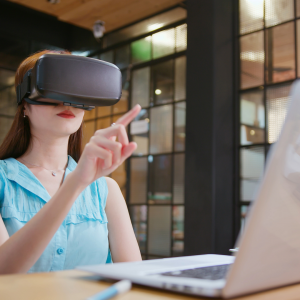 The workplace is constantly evolving, and so is how employees learn and develop their skills. Traditional training methods are being reshaped by cutting-edge technologies, offering innovative solutions that make learning more engaging, effective, and efficient.
The workplace is constantly evolving, and so is how employees learn and develop their skills. Traditional training methods are being reshaped by cutting-edge technologies, offering innovative solutions that make learning more engaging, effective, and efficient.
Explore the latest trends and innovations in technology-driven training solutions and find out how the impact of virtual reality (VR), augmented reality (AR), and artificial intelligence (AI) affect employee skill development. With these insights into how companies can leverage technology, you can enhance the effectiveness and engagement rate of employee training in your organization.
The Evolution of Employee Training
Mundane training sessions, endless PowerPoint presentations, and thick employee handbooks are gone. The modern employee expects more from training. They want it to be engaging, interactive, and tailored to their needs. This shift has given rise to technological advancements in employee training.
E-Learning Platforms
E-learning platforms, like Edusity, have gained immense popularity in recent years. These platforms offer various courses and modules that employees can access at their convenience. Whether it’s compliance training, professional development or onboarding, e-learning platforms make it easy for employees to acquire new skills and knowledge.
Edusity provides a dynamic and user-friendly learning environment that caters to a diverse set of industries and fields. Our adaptive learning system ensures that training is personalized to the individual’s pace and understanding, promoting engagement and improving retention.
Gamification
 Gamification is another technology-driven approach that’s making training more engaging. By incorporating game elements such as challenges, points, and rewards, training transforms into a fun and competitive experience. Employees are more motivated to learn when they can track their progress and compete with colleagues.
Gamification is another technology-driven approach that’s making training more engaging. By incorporating game elements such as challenges, points, and rewards, training transforms into a fun and competitive experience. Employees are more motivated to learn when they can track their progress and compete with colleagues.
Microlearning
Microlearning involves breaking down training content into bite-sized modules that can be consumed in short, focused bursts. This approach aligns perfectly with our busy lives and short attention spans, making it easier for employees to fit learning into their daily routines.
The Impact of VR, AR, and AI on Employee Skill Development
As technology continues to evolve, three particular innovations have had a profound impact on employee skill development: Virtual Reality (VR), Augmented Reality (AR), and Artificial Intelligence (AI).
Virtual Reality (VR)
VR technology immerses users in a simulated environment, creating a highly engaging and interactive training experience. In fields like healthcare and aviation, where real-life training can be costly and risky, VR offers a safe and controlled alternative. For example, medical students can practice surgery in a virtual environment, and airline pilots can simulate various flight scenarios.
Augmented Reality (AR)
 AR overlays digital information onto the real world, making it an excellent tool for on-the-job training. Employees can use AR devices or mobile apps to access real-time information, instructions, or troubleshooting guides while working. This enhances their productivity and reduces the need for extensive training.
AR overlays digital information onto the real world, making it an excellent tool for on-the-job training. Employees can use AR devices or mobile apps to access real-time information, instructions, or troubleshooting guides while working. This enhances their productivity and reduces the need for extensive training.
For example, field service technicians can use AR to get step-by-step guidance while repairing equipment, making their tasks more efficient and precise.
Artificial Intelligence (AI)
AI plays a pivotal role in personalizing training experiences. With AI-driven algorithms, training programs can adapt to individual learning styles, speeds, and preferences. It can identify areas where employees struggle and provide additional support, creating a more effective learning journey.
Enhancing Training Effectiveness and Engagement
So, how can companies leverage technology to enhance training effectiveness and engagement?
Tailored Learning Paths
One-size-fits-all training is a thing of the past. Today’s technology allows companies to create individualized learning paths for employees. By assessing their current skill levels, preferences, and job requirements, companies can provide targeted training that meets each employee’s unique needs. With Edusity you can customize, manage, and track your team’s training goals and progress.
Real-Time Feedback
Technology enables instant feedback and assessment. Companies can use interactive quizzes, assessments, and simulations to gauge employees’ understanding and progress. This feedback loop helps identify areas that need improvement and allows for timely interventions.
Social Learning
Leveraging technology for social learning is a game-changer. Employees can collaborate, share knowledge, learn from each other through online forums, and interactive platforms. This fosters a culture of continuous learning within your organization.
Mobile Accessibility
Remote work is becoming increasingly prevalent, so mobile accessibility is crucial. Training should be accessible from anywhere, on any device. Edusity, for instance, offers a responsive design that allows learners to access content from smartphones, tablets or laptops.
Analytics and Reporting
 Advanced analytic tools can provide insights into the effectiveness of training programs. Companies can track metrics like completion rates, performance improvements, and learner satisfaction. This data-driven approach helps refine and optimize your training content.
Advanced analytic tools can provide insights into the effectiveness of training programs. Companies can track metrics like completion rates, performance improvements, and learner satisfaction. This data-driven approach helps refine and optimize your training content.
Edusity is at the forefront of these technological innovations. We offer a comprehensive platform that seamlessly integrates e-learning, gamification, and microlearning to meet all your training needs.
As technology continues to advance, the future of employee training holds even more exciting possibilities. We can expect to see increased integration of VR and AR in various industries, making training more lifelike and engaging. AI will become even smarter, offering more personalized and adaptive learning experiences.
As organizations recognize the importance of employee development and invest in cutting-edge training solutions, the workforce of the future will be better prepared to meet the challenges of an ever-evolving world. Edusity, with its innovative approach to training, is poised to play a significant role in shaping that future.
 This article is contributed by Fiona Tapp, MA Ed. Tapp is a former teacher and school administrator as well as an award-winning writer.
This article is contributed by Fiona Tapp, MA Ed. Tapp is a former teacher and school administrator as well as an award-winning writer.
Angela Britcher
Latest posts by Angela Britcher (see all)
- Boost Your Teaching Career with Online Courses - May 16, 2024
- 7 Reasons to Use an LMS for Compliance Training - May 9, 2024
- Teach for Free with Edusity: Empowering Educators Worldwide - April 25, 2024